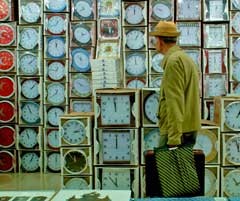Turkey, Film, 2018
Pelin
Esmer

The films of Pelin Esmer, who was born in 1972 and raised in Istanbul, “offer a perfect blend of light and shadow,” as critic Bert Rebhandl put it when discussing the start of her film “Watchtower in Deutschland” in Germany in 2014. Her films, highly evocative of chamber plays, mix documentary fictional elements as they probe the contours of life in Turkey today.
In the melodrama “Watchtower” (2012), two isolated outsiders slowly come together, thereby revealing the interior mechanisms undergirding society and how they can be undermined. Meanwhile, the documentary “The Play” (2005) portrays Anatolian village women as they rehearse a play, serving up an unsparing, yet humorous feminist discourse. Under the guise of acting, the women feel free to speak up about enduring domestic violence, everyday humiliations and exile. The film “10 to 11” (2009) depicts the contradictions of urban life – between tradition and modernity, memory and forgetting, and preservation and renewal – as experienced in the microcosm of an apartment building in Istanbul.
Along with overseeing direction, screenplay, editing and producing, in her documentary films (“The Play,” “The Collector”) Esmer takes on cinematography as well. Trained as a sociologist, to date she has created four feature-length films, which have received many international honors. She won fifteen awards for “Watchtower” (2012), including the top prize at the International Film Forum in Tashkent, an award for best direction at the Adana Golden Boll Film Festival in Turkey, a special distinction at the Nuremberg Film Festival and the jury prize in Mannheim. “10 to 11” (2009) is the winner of sixteen international awards, including the special jury prize at the Istanbul Film Festival and the top prize at Tofifest in Poland. “The Play” (2005) has also received numerous honors, including best documentary film at the Women’s Film Festival in Créteil.
As a “master micro-storyteller,” (tip Berlin, 4.16.14) Esmer’s plots develop organically out of the situation at hand. For example, “Watchtower” is a tale of a double retreat: What does the character named Seher expect from her job as steward at a lonely bus station? And why did Nihat take a job as a fireguard in a distant forest? His supervisors are constantly calling to check up on him. “Everything’s fine,” he always replies. And yet the viewer senses trouble lurking below the surface; indeed, Nihat and Seher both have something to hide. Nihat discovers Seher’s secret hidden in the bushes, when she abandons a baby she secretly gave birth to. The fireguard agrees to take in mother and child, yet Seher refuses to see her baby. To sum up, “Watchtower” depicts the boundaries that curtail female empowerment in Turkey.
The starting point of Esmer’s feature film “10 to 11” (2009) is the idea of an obsessed collector of found objects, an idea she previously explored in a documentary. The character Mithat Bey is embodied by her 83-year-old uncle, who she had already portrayed in a documentary film on the same subject. The filmmaker juxtaposes the notion of the total archive with the search for the ephemeral: Ali, 34 years old, is a doorman in Mithat’s apartment building. He pursues material possessions and wealth as the key to happiness. Conflict ensues between the two philosophies when the building is sold.
The documentary film “The Play” (2005) depicts nine women who are transformed when they work together on a play. The schoolteacher Hüsseyin unites the stories into a play brimming with attitude. Truths left unspoken in Arslanköy are uttered with a refreshing wit and outspokenness by the all-female cast. This disturbs the peace, which spells doom for the play’s premiere in the village. “Over the course of the rehearsals, the retiring village women turn into first-class actresses (…). What was at first just a way to kill time quickly becomes a matter of life and death, as their work on the play rewards them with a boost of self-confidence, recognition from their husbands and even a renewed sense of optimism for future generations. A revolution truly unfolds before the camera’s watchful eye: one that is peaceful, emotional and overflowing with joy.” (Isabelle Regnier, Le Monde)
Text: Maike Wetzel
Translation: Amy Pradell
2017: İşe Yarar Bir Şey / Something Useful
(color, 107‘)
2012: Gözetleme kulesi /Watchtower
(feature film, 1,85:1 DCP/35 mm, color, 100‘)
2009: 11’e 10 kala / 10 to 11
(feature film, HDCAM/ 35 mm, color, 110‘)
2005: The Play
(Documentary film, 4:3 DigiBeta/16:9 35 mm, color, 70‘)


